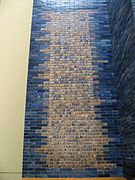Ishtar Gate


The Ishtar Gate (Template:Lang-ar) was the eighth gate to the inner city of Babylon. It was constructed in about 575 BC by order of King Nebuchadnezzar II on the north side of the city.
History
Dedicated to the Babylonian goddess Ishtar, the gate was constructed using glazed brick with alternating rows of bas-relief mušḫuššu (dragons) and aurochs.[1]
The roof and doors of the gate were of cedar, according to the dedication plaque. Through the gate ran the Processional Way, which was lined with walls covered in lions on glazed bricks (about 120 of them). Ishtar Gate depicts only gods and goddesses which include Ishtar Adad and Marduk. Statues of the deities were paraded through the gate and down the Processional Way each year during the New Year's celebration.
Originally the gate, being part of the Walls of Babylon, was considered one of the Seven Wonders of the world until it was replaced by the Lighthouse of Alexandria; in the 3rd century BC.
Excavation and display
A reconstruction of the Ishtar Gate and Processional Way was built at the Pergamon Museum in Berlin out of material excavated by Robert Koldewey and finished in the 1930s. It includes the inscription plaque. It stands 47 feet high and 100 feet wide (14 meters by 30 meters). The excavation ran from 1902 to 1914, and, during that time, 45 feet of the foundation of the gate was uncovered.
It was a double gate; the part that is shown in the Pergamon Museum today is the smaller, frontal part. The larger, back part was considered too large to fit into the constraints of the structure of the museum; it is in storage.

Parts of the gate and lions from the Processional Way are in various other museums around the world. Only three museums acquired dragons, while lions went to several museums. The Istanbul Archaeology Museum has lions, dragons, and bulls. The Detroit Institute of Arts houses a dragon. The Röhsska Museum in Gothenburg, Sweden, has one dragon and one lion; the Louvre, the State Museum of Egyptian Art in Munich, the Royal Ontario Museum in Toronto, the Metropolitan Museum of Art in New York, the Oriental Institute in Chicago, the Rhode Island School of Design Museum, the Museum of Fine Arts in Boston, and the Yale University Art Gallery in New Haven, Connecticut, each have lions. One of the processional lions was recently loaned by Berlin's Vorderasiatisches Museum to the British Museum [2]
A smaller reproduction of the gate was built in Iraq under Saddam Hussein as the entrance to a museum that has not been completed. Damage to this reproduction has occurred since the Iraq war (see Effects of the U.S. military).
Gallery
-
Photo of the remains from the 1930s of the excavation site in Babylon
-
Model of the main procession street (Aj-ibur-shapu) towards Ishtar Gate
-
Model of the gate; the double structure is clearly recognisable.
-
Aurochs and dragons from the gate in the Istanbul Archaeology Museums
-
One of the dragons from the gate
-
Building inscription of King Nebuchadnezzar II
-
Lions and flowers decorated the processional street.
-
The replica Ishtar Gate in Babylon in 2004
-
Ishtar Gate in Babylon, Iraq in 2011
References
- ^ Kleiner, Fred (2005). Gardner's Art Through the Ages. Belmont, CA: Thompson Learning, Inc. p. 49. ISBN 0-15-505090-7.
- ^ British Museum Website [1]
- Matson, F.R. (1985), Compositional Studies of the Glazed Brick from the Ishtar Gate at Babylon, Museum of Fine Arts. The Research Laboratory, ISBN 0-87846-255-4
External links
![]() Media related to Ishtar Gate at Wikimedia Commons
Media related to Ishtar Gate at Wikimedia Commons







